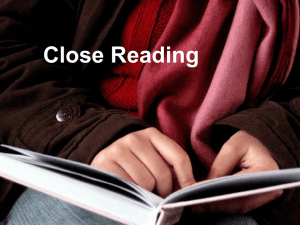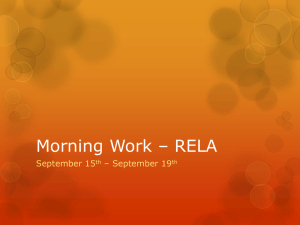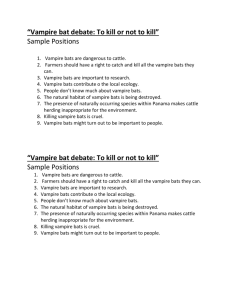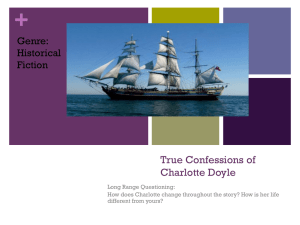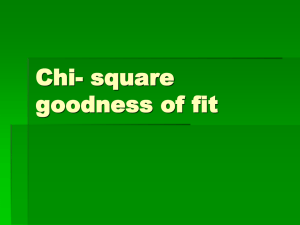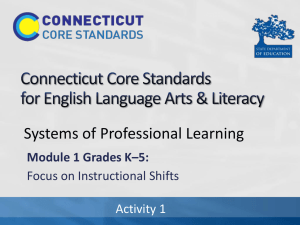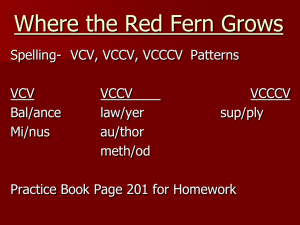Close Reading - Baldwin Jan 2014 Final
advertisement
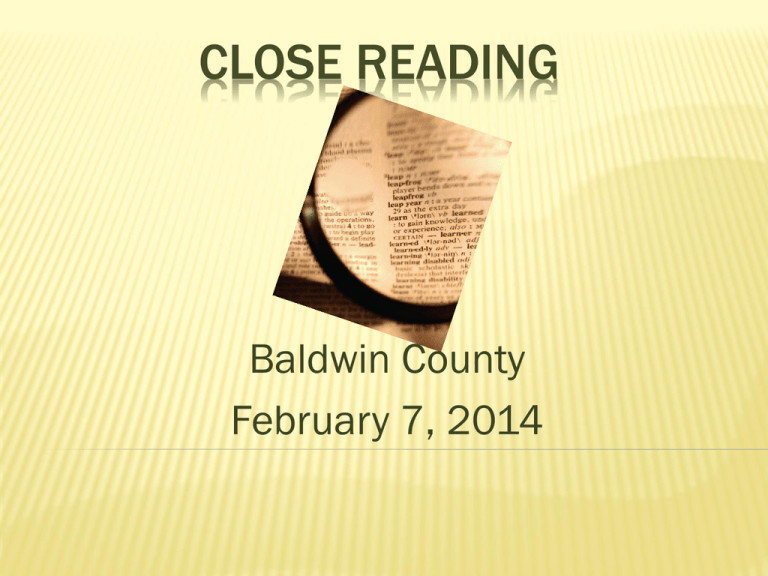
CLOSE READING Baldwin County February 7, 2014 OUTCOMES Participants will gain a deeper understanding of … What Close Reading is, how to do a close reading, and why it is important. What reading, writing, and speaking grounded in evidence from text, both literary and informational, look like in practice. How to incorporate Talk Moves in all content areas. How to plan a Close Reading lesson that incorporates text dependent questions and writing. CLOSE READING “Close Reading – an intensive analysis of a text in order to come to terms with what it says, how it says it, and what it means.” Tim Shanahan “Deep reading,” or slow reading, is a sophisticated process in which people can critically think, reflect, and understand the words they are looking at. With most, that means slowing down – even stopping and rereading a page or paragraph if it doesn’t sink in – to really capture what the author is trying to say. Experts warn that without reading and really understanding what’s being said, it is impossible to be an educated citizen of the world, a knowledgeable voter or even an imaginative thinker. -Laura Casey HOW TO DO A CLOSE READING 1ST READ TO GET THE GIST 2ND RE-READ W/ A PURPOSE IDENTIFIED BY THE TEACHER 3RD RE-READ TO ASK/ANSWER QUESTIONS ABOUT WHAT YOU’VE NOTICED CLOSE READING OF CHARLOTTE’S WEB 1. Read Charlotte’s Web Chapter to get the flow of the story. Read with a pencil in hand annotate the text 1 CLOSE READING OF CHARLOTTE’S WEB What has taken place in the story so far? Be sure to use specific textual evidence in your answer. Literal This is a story about a little girl who lives on a farm with her mother, father, and brother. Her name is Fern. The story begins with Fern’s father, Mr. Arable, setting out with an ax, and Fern asking: (Where’s papa going with that ax?) The story goes on to show that Fern is terribly upset that her father is going to kill a piglet because it is a runt and, as he says, “A weakling makes trouble.” Fern calls this event a terrible injustice and persuades her father to give her the piglet instead. CLOSE READING OF CHARLOTTE’S WEB 2. Reread paragraphs 4-14. Look for key details that might help you determine a central message or theme beginning to emerge. 3. Ask and/or answer questions about the details you’ve noticed how and why are these important to the overall text? CLOSE READING OF CHARLOTTE’S WEB What’s the story beginning to be about? Be sure to include details from the story. The story is starting to be about a struggle for justice. Fern says “It’s unfair” a couple of times. She also says it’s the most terrible case of injustice she’s ever heard of. Fern tries to wrestle the ax from her father’s hand. CLOSE READING OF CHARLOTTE’S WEB How did Fern react to her father getting ready to kill the pig? What in the story makes you say that? Fern becomes extremely upset. She is yelling and sobbing. Fern calls it, “A matter of life and death.” She even compares killing the piglet to her parents killing her if she had been born very small. CCR Anchor Standard 1 "Read closely to determine what the text says explicitly and to make logical inferences from it; cite specific textual evidence when writing or speaking to support conclusions drawn from the text.“ CCR Anchor Standard 2 “Determine central ideas or themes of a text and analyze their development; summarize the key supporting details and ideas. CCR Anchor Standard 3 "Analyze how and why individuals, events, and ideas develop and interact over the course of a text.“ “As you embrace high-level comprehension and analytical reading skills, you may need to acknowledge that many teachers never received any training or practice with these skills in their education or own reading lives.” Lucy Calkins POSSIBLE THEMES IN CHARLOTTE’S WEB Responsibility The Cycle of Life and Inevitably of Death Growing Up Standing up for what you believe in Others that are less fortunate than you CLOSE READING OF CHARLOTTE’S WEB Reread Charlotte’s Web (First 3 paragraphs on the second page) Re-Read with a pencil in hand annotate the text identify words or phrases that suggest feelings or appeal to the senses DID YOU CIRCLE, HIGHLIGHT, UNDERLINE, OR MARGINATE ANY OF THESE? Breakfast Smell of bacon, coffee, damp plaster Wood smoke from the stove Roller towel Light shone through his ears CRAFT AND STRUCTURE Read through the Craft and Structure anchor standards (4-6). Which of the standards were we able to address at your grade level? INTEGRATION OF KNOWLEDGE AND IDEAS Read through standards 7,8,9 How might you address these standards using Charlotte’s Web? What other texts and/or sources might be appropriate for layering? CLOSE READING WITH INFORMATIONAL TEXT “Close reading is purposefully reading a text several times in order to analyze and gain a deeper understanding of the text.” 1st Read = Get the gist of the text 2nd Read = Read for a purpose 3rd Read = Read to firm-up knowledge and/or another purpose INFORMATIONAL CLOSE READING 1st Read Purpose: Read the Los Angeles Times article “Vampire bat debate: To kill or not to kill” to get the flow of the story. INFORMATIONAL CLOSE READING 2ND Read Purpose: Mark the main points or arguments the author is trying to make. After your second read, jot down two or three arguments the text leads you to make. MODEL 1. State my positions or argumentsMost bats are harmless OR Bats are needed for research. nd POSSIBLE ARGUMENTS OR CONCLUSIONS Vampire bats are dangerous to cattle. Vampire bats are important to research. People don’t know much about vampire bats. Farmers should have a right to catch and kill all the vampire bats they can. Vampire bats contribute to the local ecology. The natural habitat of vampire bats is being destroyed. PARTNER WORK WITH CLOSE READING PURPOSE Share your positions with your partner. As a pair, choose one to defend. MODEL 1. The position or argumentMost bats are harmless. 2. Evidence from the article – … out of 1,100 known bat species only three are blood-sucking …… zoologist describes them as peaceful and cuddly DEFEND WITH EVIDENCE 3rd Read Purpose: Defend your position with at least two pieces of evidence directly from the article or infer from the text. Underline the textual evidence. After your 3rd read, write down the evidence from the text that defends your argument. CROSS EXAMINATION Join up with another pair. Decide who is pair A and pair B. Pair A = Share your position and evidence to pair B. Pair B = Cross examine pair A. Try to poke holes in the other pair’s evidence. Switch roles. NEXT STEP OPTIONS A. B. C. Convene with another pair and share your argument. Share with the whole class. Model writing the argument with evidence and assign students to do the same. STUDENT WORK SAMPLES Work with a partner and use the rubric to assess student writing. Prompt: Write an argument to defend your position. Use two details from the text to support your argument. Rubric: Did I write an argument that defends a position? Did I use two details from the text? Do the details support my position? RECAP- A CLOSE READING LESSON Daily (specific) Outcome: Cite textual evidence with the purpose of supporting your conclusion from a text ELA CCR Anchor Standard Reading Informational # 1 & 8 Speaking & Listening # 1, 3, & 4 Writing #1 Choose a worthy text ATTRIBUTES OF A CLOSE READING LESSON BREAK BOG SWEET BOG Close reading with a Sleuth Passage in a third grade classroom. TALK MOVES Revoicing Agree/Disagree Restating Add on Wait time CLOSE READ 3RD GRADE (SLEUTH) Video Clips – As you observe the students, look for productive Talk Moves that promote student discussion about text. Highlight the “Talk Moves” on your handout. REFLECTION ON THE VIDEO CLIPS Quick Write, Pair, ShareJot down one or two things you noticed about the student discussion. Discuss your reflections with a partner. STUDENT WORK SAMPLES PROMPTS FOR TEXT DEPENDENT QUESTIONS PLANNING A CLOSE READING LESSON Find a partner. Choose a grade level for planning a Close Reading lesson using a selection from Sleuth. PLANNING FOR A CLOSE READING LESSON 1. 2. 3. Daily (specific) Outcome: Cite textual evidence with the purpose of supporting your conclusion from a text ELA CCR Anchor Standard Reading Informational # 1 & 8 Speaking & Listening # 1, 3, & 4 Choose the text PLANNING FOR A CLOSE READING LESSON 1. 2. 3. 4. 5. What College and Career Ready Standards will I address? What is my desired outcome for this lesson? What steps will I take to reach my outcome? How will we know when each student has met the desired outcome? What will I do if learning does/does not occur? SHARE YOUR PLAN Find another set of partners. Share your plan. E-mail your completed lesson plan to aguy@bcbe.org. A FINAL THOUGHT…. “If young readers do the work of the first three anchor standards well— comprehending, inferring, synthesizing —then they’ll move rapidly up levels to the kinds of stories where paying attention to craft, structure, and language will become an essential part of their everyday reading work.” -Calkins, Ehrenworth, & Lehman, 2012 TICKET OUT OF HERE! Quick Write- How do you plan to share the information from today with others at your school?
